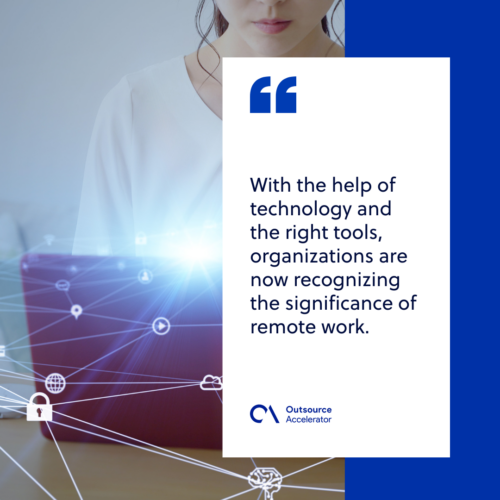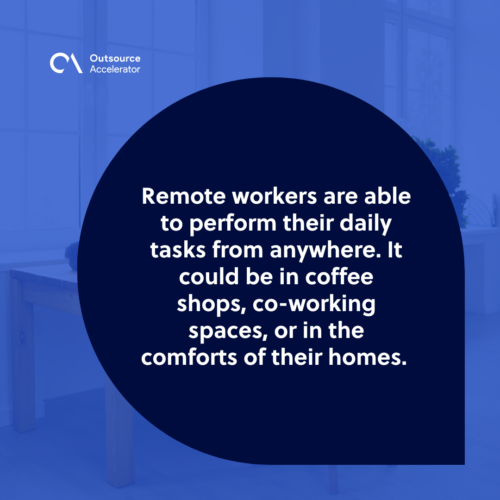Your absolute guide to managing your remote employee

In the upsurge of the COVID-19 outbreak, everyone around the world was pushed to quickly adapt to a work-from-home setup.
No business was ever prepared to fully work remotely as they went on with their day-to-day operations. During the first few stages of lockdowns, it was a struggle for employers and managers as there are certain challenges to managing a remote employee.
But with the help of technology and the right tools, organizations are now recognizing the significance of remote work. A lot of companies today are progressively transitioning to working remotely.
However, what we are not all aware of is that there are actually firms that have been in this practice even before the pandemic. As a matter of fact, statistics show that 17% of U.S. staff have been on a work-from-home setup 5 days or more each week.
Remote work is indeed not an obstruction to remote workers productivity. It is clearly here to stay. It is expected that different remote work models like hybrid work will carry on even post-COVID.
As an employer, how do you successfully manage your remote workers? What other things can you do to cultivate an ideal remote work environment with your employees?
After all, there are copious benefits of working remotely both on the employers and employees side, if done right.

Understanding remote work and remote employee
Remote work has become even more relevant due to the COVID-19 pandemic. As a business leader, working from home allows you to save money. You won’t be required to spend more on your workplace needs like utilities, office rentals, janitorial services and even parking slots.
You are also given the opportunity to hire robust talents from anywhere rather than limiting your search within your geographic location. Working remotely enables you to tap into a highly skilled global talent pool.
Now to help you effectively manage your remote workforce, here’s what you should know about a remote employee.
What is a remote employee?
A remote employee is someone that works outside a traditional office environment setup. Remote workers are able to perform their daily tasks from anywhere. It could be in coffee shops, co-working spaces, or in the comforts of their homes.
Remote employees are not the same as freelancers. These are people that you hire for full time remote work or a mix of in-house and remote tasks. Some organizations that execute a distributed workforce provide allowances for co-working space or home-office.
Additionally, there are some who hire outsourcing companies, like Cloudstaff, to help you recruit the right remote team, or cloud staff, for their businesses.
What makes an ideal remote employee
In hiring remote employees, note that you have the option to outsource this process or keep it within your management. Either way, here are the traits you should look for in searching for the right talent:
Proactiveness
Proactive employees do not just sit around and wait for something to happen. These are people who still find something to do even without a list of tasks given to them, or even if they have already finished all tasks given to them.
Organized
Organizational skills is very important in a remote work environment. There could be times when your division of remote tasks may be unclear.
However, an ideal remote employee knows how to prioritize which tasks to focus on first. More so, is able to complete all work given accordingly.
Self-motivated
A good remote employee should be able to work independently without your constant supervision. Self-motivated staff have the ability to set personal routines that make them productive even without constant updates from you.
Excellent communication skills
Excellent communication skills apply both verbally and in writing. Remote teams commonly communicate through group chat, email, or private messages. You should be able to hire someone that can clearly communicate with you and your team at your standard.
An excellent communicator is able to relay information directly, with clarity and in a professional manner. It is also someone who is not afraid to ask questions or help whenever a task or a project is unclear.
Trustworthy
In order for remote work to be successful, you should be able to trust your team. Ensure that whoever you hire is reliable and can be trusted. This will help you avoid future headaches and serious repercussions.
Collaborative
Your remote employee should be a team player. Your entire remote team should be able to work together to be more efficient and effective.
As an employer, it is also your responsibility to set specific expectations in discussing new projects.
Tech savvy
A typical daily remote work revolves around utilizing different communication and collaborative tools. This is why it is essential for a remote employee to be adept in using different tools, software and other online portals.

Possible drawbacks to hiring a remote employee
Although working from home has become a common practice, there are still possible drawbacks in working with a remote staff:
Personal supervision
The lack of physical supervision is a common concern for business leaders and employees. Employers and managers often fear that their remote employees do not work as hard and efficiently as they would in the office.
On the other hand, remote workers also struggle with not having enough access to management support and communication. In other cases, employees may tend to feel like their needs are not properly addressed.
Quick access to information
This usually applies to newly hired remote staff. Sometimes, they have to exert extra time and effort to get specific information from co-workers or supervisors. This challenge can string out from task-related to interpersonal communication within the team.
Miscommunication
Miscommunication is unavoidable in a remote work environment. This is due to the fact that you will not have the same face-to-face interaction with your team as if you were in your physical office.
Cultural and language differences
Remember that if you will be hiring a remote employee that is in another country, cultural & language barriers are inevitable. Even if you work with someone that is fluent in the English language, you should still be aware of such cultural differences.
BPO partners, such as Remote Staff, have years of experience in matching businesses to the right remote teams. They help bridge cultural gaps to build a stronger working relationship between in-house and virtual employees.
Distractions at home
You may have already seen trending videos or photos online of employees with a child in hand during zoom calls. That is actually the reality of working from home.
Considering that fact, it is highly advisable to make sure that your remote employee has a designated workspace free from possible distractions.
Keep in mind that all these obstacles can be regulated and overcome through proper remote management methods.
Tips in managing your remote employee
Here’s what you can do to manage your remote team effectively and successfully:
Provide options for different communication channels
Make sure that your team is able to engage and interact with one another through different forms of communication. Making use of email is not enough especially for urgent concerns.
Use communication tools for chats, video conferencing and voice calls. Examples for these communication channels are Skype, Google Hangouts, and Zoom.
Cloud staffing pioneer Cloudstaff can also assign a highly-trained supervisor to ensure proper communication between you and your remote employees.
Provide the right tools
Provide collaborative tools where everyone in your team can track their tasks and projects’ progress. Tools like Asana and Slack allow you to create reports, share files, brainstorm ideas, and distribute tasks.
You can also use these tools for project management, and communication.
Set clear expectations
Set boundaries and provide guidelines before working on a new project or in on-boarding new employees. Be clear with your goals and expectations, including which tasks your remote team should prioritize first.
Be consistent
Be consistent on your instructions, rules, responses and evaluations. Consistency is a vital characteristic that a leader should possess. This is especially important if you’re managing employees from a distance.
It is also a key element in establishing a healthy remote work environment that is diverse and stable.
Make time for remote social interactions
Remote social interactions like virtual team buildings or parties allows you to strengthen working relationships within your organization.
These types of events are also very helpful in mitigating loneliness or feelings or isolation. In addition, it is a good time for you to catch-up with your remote employees and get to know them more.
Foster emotional support and encouragement
As an employer, you should also be able to empathize with your remote employees. Listen to their concerns and struggles. At the same time, acknowledge their stress and anxieties.
You can simply ask them how they are doing. Make sure that you listen carefully to what they are saying and let their concerns be the focus of the conversation.
Effective leaders are able to acknowledge whatever their employees are going through. Whilst also providing words of affirmation like “we’ve got this” or “I know this is tough, but we can handle it” to encourage the team.

No to micromanaging
It is also important that you resist the urge to micromanage. Instead, have regular check-ins like one on one sessions with each remote employee. Be able to establish trust within your remote team.
As long as they are able to meet deadlines, provide quality outputs and are communicating clearly then there is no need to worry. Trust that your remote employees are working productively and efficiently.
Of course, don’t forget to recognize your remote team’s hard work. Celebrate every milestone and give credit where credit’s due.
While you’re here, you may as well want to listen to one of our podcast episodes. In this episode, Outsource Accelerator CEO Derek Gallimore talks about the pros and cons of working from home!







 Independent
Independent




